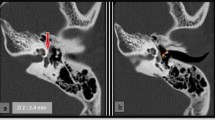Abstract
The objective of the study was to investigate the relationship between extent of otosclerotic foci and audiological findings in otosclerotic patients with mixed hearing loss using high-resolution computed tomography (HRCT) and also to measure the density of bony labyrinth in otosclerotic patients and compared with control group. This was a retrospective study. Twenty-five patients with clinical otosclerosis and mixed hearing loss were included in the study. The average threshold of air-bone conductions (AC, BC) within the 0.5–4 kHz frequency range, and average air bone gap (ABG) were calculated. Eleven patients with normal HRCT who received cochlear implant were included in the study as the control group. The lesions in HRCT were staged according to their extension. Eight different points of the otic capsule in each patient were measured using HRCT. Fifty ears total, from 25 patients, had bilateral otosclerosis. The mean AC of all the ears was 63 dB, mean BC was 35.2 dB, and mean ABG was 27.8 dB. HRCT staging indicated 22 ears had Grade 1, 21 ears had Grade 2, and 7 ears had Grade 3 lesions. There was a statistically significant difference between the mean AC, BC of ears with Grade 1 and Grade 2 when compared with the mean AC, BC of ears with Grade 3. When comparing the densitometric measurements of fissula ante fenestram localizations, a statistically significant difference was observed. HRCT examination and densitometric measurements in otosclerotic patients with mixed hearing loss presented significant results. We were unable to show a significant relationship between early stage and hearing thresholds, but there was a significant relationship in advanced stage. Densitometric measurements may provide significant results for otosclerosis, particularly for the FAF region when comparing with control group.


Similar content being viewed by others
References
Makarem AO (2010) Cavitating otosclerosis: clinical, radiologic, and histopathologic correlations. Otol Neurotol 31:381–384
Uppal S, Bajaj Y, Rustom I et al (2009) Otosclerosis: the aetiopathogenesis of otosclerosis. Int J Clin Pract 63:1526–1530
Valvassori GE (1993) Imaging of the otosclerosis. Otolaryngol Clin North Am 26:359–371
Rotteveel LJ, Proops DW, Ramsden RT et al (2004) Cochlear implantation in 53 patients with otosclerosis: demographics, computed tomographic scanning, surgery, and complications. Otol Neurotol 25:943–952
Lagleyre S, Sorrentino T, Calmels MN et al (2009) Reliability of high-resolution CT scan in diagnosis of otosclerosis. Otol Neurotol 30:1152–1159
Causse JR, Uriel J, Berges J et al (1982) The enzymatic mechanism of the otospongiotic disease and NaF action on the enzymatic balance. Am J Otol 3:297–314
Lee TC, Aviv RI, Chen JM et al (2009) CT grading of otosclerosis. Am J Neuroradiol 30:1435–1439
Shin YJ, Fraysse B, Deguine O et al (2001) Sensorineural hearing loss and otosclerosis: a clinical and radiological survey of 437 cases. Acta Oto Laryngol 121:200–204
Kiyomizu K, Tono T, Yang D et al (2004) Correlation of CT analysis and audiometry in Japanese otosclerosis. Auris Nasus Larynx 31:125–129
Schuknecht HF, Barber W (1985) Histologic variant in otosclerosis. Laryngoscope 95:1307–1317
Nelson EG, Rark H (2004) Questioning the relationship between cochlear otosclerosis and sensorineural hearing loss: a quantitative evaluation of cochlear structures in cases of otosclerosis and review of the literature. Laryngoscope 114:1214–1230
Kawase S, Naganawa S, Sone M et al (2006) Relationship between CT densitometry with a slice thickness of 0.5 mm and audiometry in otosclerosis. Eur Radiol 16:1367–1373
Grayeli AB, Yrieix CS, Imauchi Y et al (2004) Temporal bone density measurements using CT in otosclerosis. Acta Otolaryngol 124:1136–1140
Acknowledgments
No fund was obtained to complete this work.
Conflict of interest
No conflicts of interest are present.
Author information
Authors and Affiliations
Corresponding author
Rights and permissions
About this article
Cite this article
Kutlar, G., Koyuncu, M., Elmali, M. et al. Are computed tomography and densitometric measurements useful in otosclerosis with mixed hearing loss? A retrospective clinical study. Eur Arch Otorhinolaryngol 271, 2421–2425 (2014). https://doi.org/10.1007/s00405-013-2729-0
Received:
Accepted:
Published:
Issue Date:
DOI: https://doi.org/10.1007/s00405-013-2729-0




